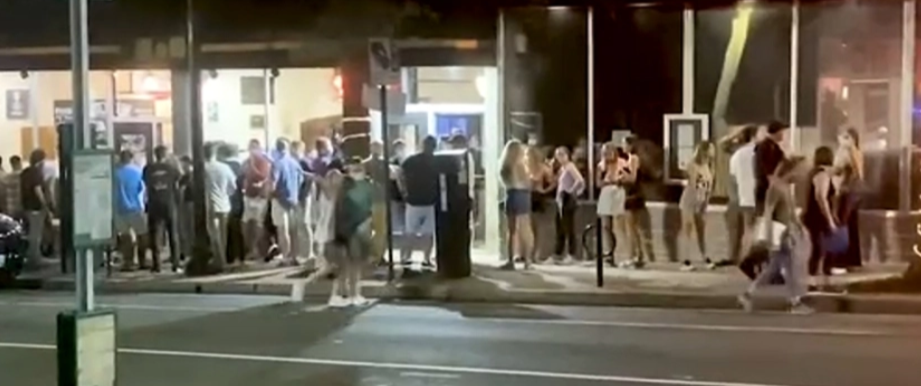
by James A. Bacon
One of the virtues of Arlington County is the brilliant job that county planners have done in working with developers and property owners to create walkable streetscapes. The existence of pedestrian-friendly sidewalks, intersections and building setbacks — creating public urban spaces where people enjoy dining, shopping, and mingling — are a key to the county’s livability. Judging by the prices of real estate, people are willing to pay a tremendous premium to live there.
Now the Arlington Board has enacted an ordinance prohibiting people from gathering in groups or more than three, and directing pedestrians to keep a distance of at least six feet on certain streets and sidewalks. Signs will be posted, and failure to comply could result in a $100 fine.
“While most Arlingtonians are adhering to requirements to wear masks and maintain social distancing, unfortunately, some are not,” said Board Chair Libby Garvey in a press release. County officials have observed “significant crowding” inside restaurants and on public sidewalks, rights of way and adjacent public spaces. “[People] are putting themselves and our community at risk of serious illness or death during the COVID-19 pandemic.”
Will the perception change the balance of economic and demographic power between large metros like Washington, of which Arlington is part, and smaller metros and even rural counties? That’s a question raised in the new edition of the Virginia Economic Review, a quarterly publication of the Virginia Economic Development Partnership.
The Virginia Department of Health COVID-19 dashboard indicates that Arlington has had nearly 16,000 confirmed cases, leading to 435 hospitalizations and 136 deaths. The press release proffered no data, however, establishing a link between outdoor crowding. The county, which continues to operate a local bus system, “encourages” social distancing and asks riders to use the buses for “essential travel” only but, judging from the Arlington Transit website, has imposed no restrictions comparable to the sidewalk crackdown.
Whether one agrees with the board or not, the action drives home the perceived hazard of living in dense urban environments during a plague. The longer the COVID-19 crisis lasts, the deeper lessons learned from the epidemic will burn themselves into the public consciousness.
In the Review, VEDP President Stephen Moret, taps a wide range of pundits and thinkers from around the country to opine on the implications of the coronavirus for cities and towns, the workforce, supply chains, site selection and other topics. As one of the pundits profiled suggested, the perception is increasing that “density equals danger.” Here follow some of the key insights.
COVID favors amenity-rich small towns. With the untethering of high-tech jobs from office buildings and the growing sense that “density equals danger,” local officials in small towns are betting that some technology workers will elect to live in less crowded communities, says Anita Brown-Graham with the University of North Carolina School of Government. “Of those who do leave big cities, many are likely to follow the trend that began before the pandemic, favoring college towns or amenity-rich mid-sized cities.” She adds: “Small towns need to cultivate and support the local entrepreneurs who boost creative connections and placemaking.”
Retrofitting for social distance. As many as three-quarters of small businesses could go bankrupt as a result of the virus, says Richard Florida, author of The Rise of the Creative Class. Survivors, he says will look different in the future. “Stores, restaurants, offices, and factories will have to make design changes to allow for physical distancing. Similar retrofits will be necessary in airports, arenas, public transportation, and other high-capacity spaces. Enhanced infrastructure for pedestrians and bikers will allow for safer commuting.”
Rethinking the push for density. Given the strong tie that exists worldwide between density and exposure to the pandemic, local governments will need to reconsider the rush to density, writes Joel Kotkin, an urbanologist and Chapman University professor. “Planners, often inured to the public’s preferences, still ignore that recent Census data surveys have already revealed a secular shift to smaller, less dense places — both suburbs and cities. This tend will only grow, as recent surveys show that nearly 30% of big-city residents are considering a move out to a less dense place.” Speaking of Virginia, Kotkin said that a major imperative will be accommodating the growing number of home-based knowledge workers who have more flexibility in where they live.
A three- to five-year event. No one knows how long the COVID-19 epidemic will last but it won’t be a three-year event, says Karl Stauber, former CEO of the Danville Regional Foundation. It’s more likely to be a five-year even. Automation and telework will increase. Supply chains will shorten. Large urban areas will be less attractive, creating opportunities for agile, smaller communities. “Communities must become much more strategic in their investments — regional approaches will be even more critical.”

Leave a Reply
You must be logged in to post a comment.